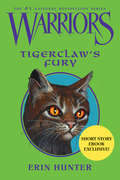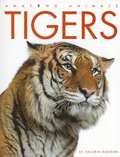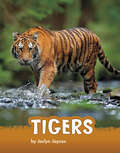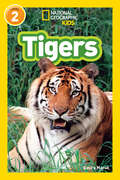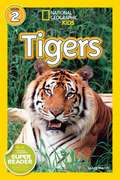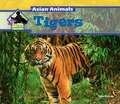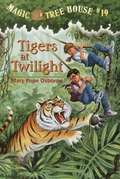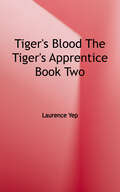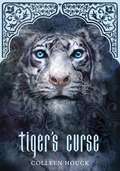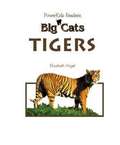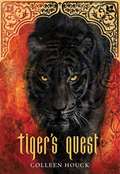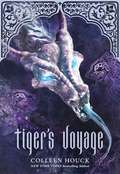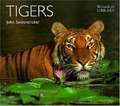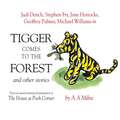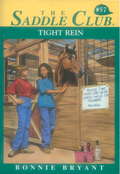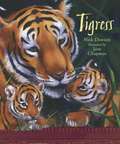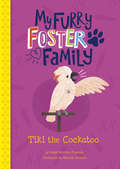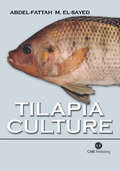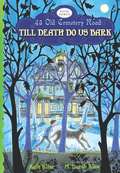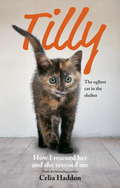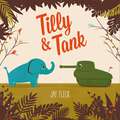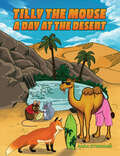- Table View
- List View
Tigerclaw's Fury: Tigerclaw's Fury (Warriors)
by Erin HunterIn this seventy-five-page novella from the world of Erin Hunter's #1 nationally bestselling Warriors series, discover the story behind Tigerclaw's rise to power as leader of ShadowClan. Cast out of ThunderClan as a traitor, Tigerclaw will not rest until he has his revenge on Bluestar, Fireheart, and the rest of his former Clanmates. But first he must become Tigerstar of ShadowClan. . . .Readers will be thrilled at this look into the ruthless heart of one of the most infamous cats in the Warriors series. Warriors: Tigerclaw's Fury also includes teaser chapters of Warriors: Leafpool's Wish and Dawn of the Clans #1: The Sun Trail.
Tigers (Animals)
by Jaclyn JaycoxTigers are the largest wildcats in the world. These skilled hunters sneak up on prey and pounce with incredible speed and power. Learn more exciting facts about these majestic hunters.
Tigers (Readers)
by Laura MarshWith their bold black stripes, powerful presence, and fierce faces, tigers are just about the coolest animal on the planet. These giant jungle cats can climb trees, swim, and run in sprints up to 32 mph—making them a predatory nightmare. Ranging from the warm climates of Southeast Asia to the frozen tundra of western Russia, these solitary hunters will devour whatever animal they catch. In this level 2 reader you'll learn all you ever wanted to know about tigers and so much more. Complete with fascinating facts, beautiful images, National Geographic Readers Tigers can't miss.National Geographic supports K-12 educators with ELA Common Core Resources.Visit www.natgeoed.org/commoncore for more information.
Tigers (National Geographic Readers for Kids #Level 2)
by Laura Marsh National Geographic Kids StaffTigers are big and beautiful animals. They are strong and powerful, too. Tigers are the biggest cats in the world.
Tigers (Asian Animals)
by Julie MurrayPresents information about tigers, including where they live, what they are like, how they behave, what they eat, how they raise young, and the things that threaten them as a species.
Tigers at Twilight (Magic Tree House #19)
by Mary Pope OsborneHaving used their magic tree house to travel to India, where they must get a gift to help free the dog Teddy from a spell, Jack and Annie have adventures involving a tiger and other endangered jungle animals.
Tiger's Blood (The Tiger's Apprentice)
by Laurence YepA Chinese American boy and his friends—a monkey, a dragon, a rat, and a tiger—must ensure that a magical phoenix egg does not fall into evil hands in the underwater dragon kingdom.
Tiger's Curse (Tiger's Curse #1)
by Colleen HouckThe last thing teenager Kelsey Hayes thought she'd be doing over the summer was meeting Ren, a mysterious white tiger and cursed Indian prince! When she learns she alone can break the Tiger's curse, Kelsey's life is turned upside-down.
Tigers (Nature's Children)
by Bill IvyDescribes the physical features, habits and natural environment of this the largest of the big cats.
Tigers (PowerKids Readers: Big Cats)
by Elizabeth VogelSimple text introduces the reader to the tiger and its characteristics
Tiger's Quest (Tiger's Curse #2)
by Colleen HouckBack in Oregon, Kelsey tries to pick up the pieces of her life and push aside her feelings for Ren. But danger lurks around the corner, forcing her to return to India where she embarks on a second quest--this time with Ren's dark, bad-boy brother Kishan, who has also fallen prey to the Tiger's Curse. Fraught with danger, spellbinding dreams, and choices of the heart, TIGER'S QUEST brings the trio one step closer to breaking the spell that binds them.
Tiger's Voyage (Tiger's Curse #3)
by Colleen HouckWith the head-to-head battle against the villainous Lokesh behind her, Kelsey confronts a new heartbreak: in the wake of his traumatic experience, her beloved Ren no longer remembers who she is. As the trio continues their quest by challenging five cunning and duplicitous dragons, Ren and Kishan once more vie for her affections--leaving Kelsey more confused than ever.
Tigger Comes To The Forest & Other Stories (Winnie the Pooh #1)
by A.A. MilneJoin Pooh and Piglet as they make a new friend, Tigger, who bounces his way into the Hundred Acre wood, performed by an amazing all-star castPerformed by incredible talent including Finty Williams, Stephen Fry, Sandi Toksvig, Robert Daws, Jane Horrocks, Geoffrey Palmer and Judi Dench, this classic Winnie the Pooh audiobook is perfect for keeping little ones entertained.Contains the following stories:In which a house is built at Pooh Corner for EeyoreIn which Tigger comes to the forest and has breakfastIn which Tigger is unbouncedIn which Eeyore finds the Wolery and Owl moves into itIn which Christopher Robin and Pooh come to an enchanted placeFor more amazing audio books featuring Pooh, Piglet, Tigger, Eeyore and other favourite friends, try:Winnie the Pooh: House at Pooh CornerWinnie the Pooh: Piglet Meets a HeffalumpWinnie the Pooh: Pooh Invents a New Game and Other Stories (P) Hodder Children's Books 1999
Tight Rein (Saddle Club #57)
by Bonnie BryantStevie Lake has been grounded. No hanging out with the other members of the Saddle Club. Even worse, Stevie's not allowed to ride! It's going to take all her wackiness, and a little help in the scheming department from Carole Hanson and Lisa Atwood, to talk her parents into letting her go to riding camp. Can Stevie clean up her act in time? If she doesn't, summer is going to be a complete bust!
Tigress
by Helen CowcherAuthor Helen Cowcher addresses environmental concerns in this children's book. A tiger and her cubs leave their forest sanctuary to hunt. What will happen when they unknowingly attack a farmer's bull?
Tigress
by Nick Dowson Jane ChapmanMoving smooth as a river, her stripy coat bright as fire, a mother tiger runs, then vanishes into the tall grass. With plate-sized paws and a pink nose the size of your fist, she hunts and swims, cares for her cubs, and teaches them all her tiger tricks. In a lyrical narrative interspersed with many intriguing facts, Nick Dowson reveals the hidden ways of a wild tigress and her cubs, while Jane Chapman brings the mysterious creatures to rippling, roaring life.
Tiki the Cockatoo (My Furry Foster Family)
by Debbi Michiko FlorenceTiki the cockatoo is the Takano family's newest foster pet and thanks to her ear-splitting screeching, the entire neighborhood knows it! Eight-year-old Kaita has to pull out all the tricks to keep the feathered squawker calm and content and find Tiki a forever home before everyone goes crazy! Giggle-inducing illustrations and 1st-person narration bring this noisy early chapter-book adventure to life.
Tilapia Culture
by Abdel-Fattah M. El-SayedTilapia culture is currently practiced in 95 countries all over the world and the number is expected to increase. This book discusses in detail the principles and practices of tilapia culture in the world. It covers all the vital issues of farmed tilapia including: the biology, environmental requirements, semi-intensive culture, intensive culture systems, feed and feeding, reproduction and breeding, spawning and larval rearing, stress and diseases, harvesting and marketing and the role of tilapia culture in rural development. It also highlights and presents the experiences of leading countries in tilapia culture.
Till Death Do Us Bark (43 Old Cemetery Road #3)
by Kate Klise M. Sarah KliseWhen a dog arrives at Spence Mansion, Seymour is overjoyed. His adoptive parents, Ignatius B. Grumply and Olive C. Spence, are less enthusiastic--especially when Secret, the dog, begins barking all night long. Is it possible Secret just misses his old companion, the late Noah Breth, whose children are fighting like cats and dogs over their father's money? Or does Secret have a secret that, in the end, will make the entire town of Ghastly howl with delight?
Tilly: How I Rescued Her and She Rescued Me
by Celia HaddonTilly has spent most of her adult life in an Oxfordshire shelter, unchosen, unwanted and practically feral. Seeking a distraction from her own troubles, the author and renowned pet columnist, Celia Haddon begins a project to transform Tilly into a household pet. Through Tilly's journey from unwanted and unadoptable cat to adored pet, Celia begins to explore her own inward journey and the way that cats had helped her through the difficulties of childhood and middle age, through to self knowledge. By loving Tilly she found she could love her inner self.
Tilly: How I Rescued Her and She Rescued Me
by Celia HaddonTilly has spent most of her adult life in an Oxfordshire shelter, unchosen, unwanted and practically feral. Seeking a distraction from her own troubles, the author and renowned pet columnist, Celia Haddon begins a project to transform Tilly into a household pet. Through Tilly's journey from unwanted and unadoptable cat to adored pet, Celia begins to explore her own inward journey and the way that cats had helped her through the difficulties of childhood and middle age, through to self knowledge. By loving Tilly she found she could love her inner self.
Tilly and Tank
by Jay FleckA sweet and funny picture book that looks at the blossoming friendship between an elephant and a tank and encourages kids to make friends, not war. Tilly the elephant is taking her morning stroll when she notices something strange on the horizon. Is it another elephant? The newcomer has a trunk and tail, but he's a very curious shade of green. Tank, on the other hand, notices an odd-looking creature approaching. It has a barrel and a turret, like Tank, but is a curious shade of blue. Is it a new enemy tank? Tank's alarm sounds and he goes BOOM, scaring Tilly off. But when Tilly returns with a flower, Tank begins to understand that she might not be an enemy at all. Tilly and Tank is a heartwarming tale of friendship, peace and understanding by debut author/illustrator Jay Fleck.
Tilly the Mouse: A Day at the Desert
by Sara StronachAdventure calls as Tilly the daring mouse and her lively friends embark on a thrilling desert quest brimming with mystery and excitement. Chance lures the endearing gang into a competition quite unlike any faced before, one demanding every ounce of their collective wit and teamwork to triumph. Yet the desert’s vibrant domain holds even greater rewards in store – fast friendships forged and wonders revealed to make stalwart spirits soar. Tilly soon discovers that when open hearts meet joy’s golden grace, adversity itself transforms into the stuff of dreams. Both imagination and tender affection will find ardent ignition in this grandest of tales blessing all creatures great and small. For beyond thrills, beyond even victory’s sweet song lies the lasting magic of camaraderie and wisdom sent to see us through life’s journey long after the final page.
